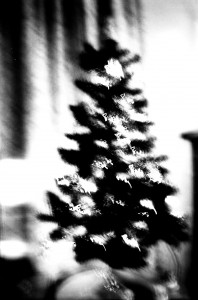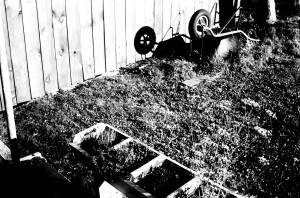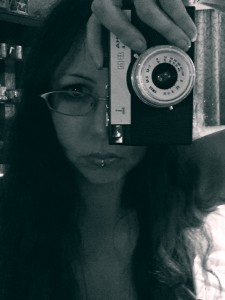One thing I love about art – and one thing that I, admittedly, have some difficulty with in my medium of choice, i.e. writing – is experimentation. One of the most liberating aspects of art is the ability to make big, messy mistakes and glory in them, or to discover they aren’t mistakes at all. When we don’t let ourselves make mistakes, or messes, we rob ourselves of the joy of Making Art.
Years ago I was convinced I could never write a novel because I would sit down for one or two sessions and then never touch the file again. It was NaNoWriMo that taught me I could, and that even if the result was an absolute clusterfuck, that the value of the words I had written and the squirming foetus of a novel I had created were nevertheless of tremendous value and potential. Even if I closed the file in December and never looked at it again, that was 50,000 words of writing practice, and that was valuable. That should be viewed with satisfaction. That was a massive epiphany for me.
There is nothing I can think of that was more important to my work personally as a writer than allowing myself to write crap. Without the pressure that everything one does be good, one can get so much more actually written, that can then be refined into something good. NaNo gave me the freedom to keep moving forward, the confidence to leave errors be, and the don’t-touch-that-delete-button momentum.
I can’t draw for toffee, but I get my visual art on through the medium of photography. I have a little entry-level DSLR and have a folder or two of images of which I am tremendously proud. The advantage of digital is that mistakes can be immediately deleted and forgotten. You press the shutter, and it was not a good shot, so you adjust and press it again, barely thinking about it. You can take a million shots, so you can keep snapping until you achieve the perfection you seek. Even if you keep the RAW files of the rejects, you’re not likely to look at them again, let alone mess with them to see what can be done. So on the one hand you have the freedom to make mistakes as they do not matter, but on the other, the mistakes themselves are never viewed.
Creative messes keep the juices flowing. I seek them out, now. Notebooks full of run-on sentences, 50k manuscript rejects, Wreck This Journal… I had my eye on the latter for years and only bought it a few months ago,. It’s great fun and I hope to get my little cousins onto it, so they can learn to make art without the spectre of the Inner Editor criticising their messes. At least one of them is already pretty self-conscious. I see myself in her, in many ways, and she’d start out so far ahead of me if she avoided acquiring an inner editor in her teens.
That’s what I like about lomography, actually: it gives one the freedom to make mistakes, and then revel in what those mistakes produce. It’s experimental. You put a roll of film in a 30 year old Russian camera and see what comes out. And, yes, it does have a certain “hipster” quality, and there’s the eyeroll-inducing implication that shitty light leaks and expired film instantly make something “art”, and yet, this form of photography is different enough from the “line it up and work it RAW” digital perfectionism. I like the idea of taking something crap, something discarded, like a broken old camera or an expired roll of film, and using it in different circumstances to see what you get back from it. I like the experimentation of lomography. I like being put in that new position as a photographer and stretching my experience in new directions. And, even though instant gratification is one of the things I love about digital photography, I must admit that I like not knowing what you’ll get until you receive your prints back. Even if the result is “what the hell is that??”, to me, that’s a good result. I love having a creative outlet for which there is no perfectionism, no forethought, and sometimes, no afterthought – in which I can just play around and see what I get.

The result can be, well, trash, but it’s interesting trash, especially when using a film one hasn’t used before. The image above wasn’t supposed to be as blurred as it ended up – curse my unsteady hand! – but I had no idea at the time the degree of contrast on the 80 ISO black and white retro film I was using. I was stunned when I got the pictures back. I am all about contrast in my black and white photos. And the charm, in this sort of photography, is in the mess. It wouldn’t be an interesting picture at all had I taken it with my DSLR, turned up the contrast and set it in monochrome, but somehow, here, it is.
There’s something distant about lomography, too, something I can’t quite put my finger on. It makes many lomo images seem sad and cold, detached, lonely. As if the blur and the image issues and the light leaks and the colour vibrancy and all of the things people love about lomography put distance between viewer and subject rather than bringing you together. To me, that’s part of the appeal. I love that sort of gritty sorrow.

I’ve backed Lomography’s kickstarter for an instant Lomo camera, as instant cameras are something I’ve loved since I was a child but never had. Instant tangible photos! Things to post to people! To stick in a journal or onto a wall or leave in library books for strangers! I’m checking back on the kickstarter every hour, obsessively, and watching the number tick up. (“It has to reach a million! I want that extra lens, damnit!”) Kickstarter is that sort of website for me. When there’s a project that really excites me, I’m back there all the time, update or no, seeing what other people are saying about it and what number it’s reached now.
Sometimes I’m sitting with a notebook and nothing. I can read books on writing and read books for the fiction and flick through quotes from artists and writers and feel that swell of creativity, and yet…. nothing. But I find I can tap into that juice by switching medium. I’m dry on the writing front, but maybe I can take some good pictures today. I’m all out of film, but I have all these RAW files that need to be edited, and that can be creative process in its own right. Nothing’s coalescing visually for me today, but I can manipulate this feeling and turn it into poetry.
I backed Amanda Palmer’s kickstarter back in 2012 – she’s another mess-maker I consider a huge inspiration – and went for the arts and crafts package. Part of one of those parcels was a Moleskine notebook. Now, I have a great many notebooks, more than by rights I should have, and so here was a new one, a rather lovely one, and I already had a writing exercises notebook and a prosey bits notebook and a journal and a notebook of inspirational quotes and writing prompts. What to do with this new one? I decided in the end to use it to tease out ideas; to make messes. I’d take a sentence that had popped into my mind – “Take out my heart and serve it with vinegar” – that was an orphan with nowhere to go, and I’d tease it out. I’d take the idea one way, decide that was terrible and start on a new page to take it in another. It’s an artistic exercise I really like. Sometimes I get a great piece out of it in the end, and sometimes I have nothing at all but a series of bad attempts, but I know what works with the idea and what doesn’t. I still don’t know where “Take out my heart and serve it with vinegar” is going. Cannibalism was a dead end. The broken-hearted lover angle didn’t pan out the ways I tried it, but I think if I twist it around enough, I can find something there.
Go forth, friends: Make Good Art and big, joyful messes.
xoxo
